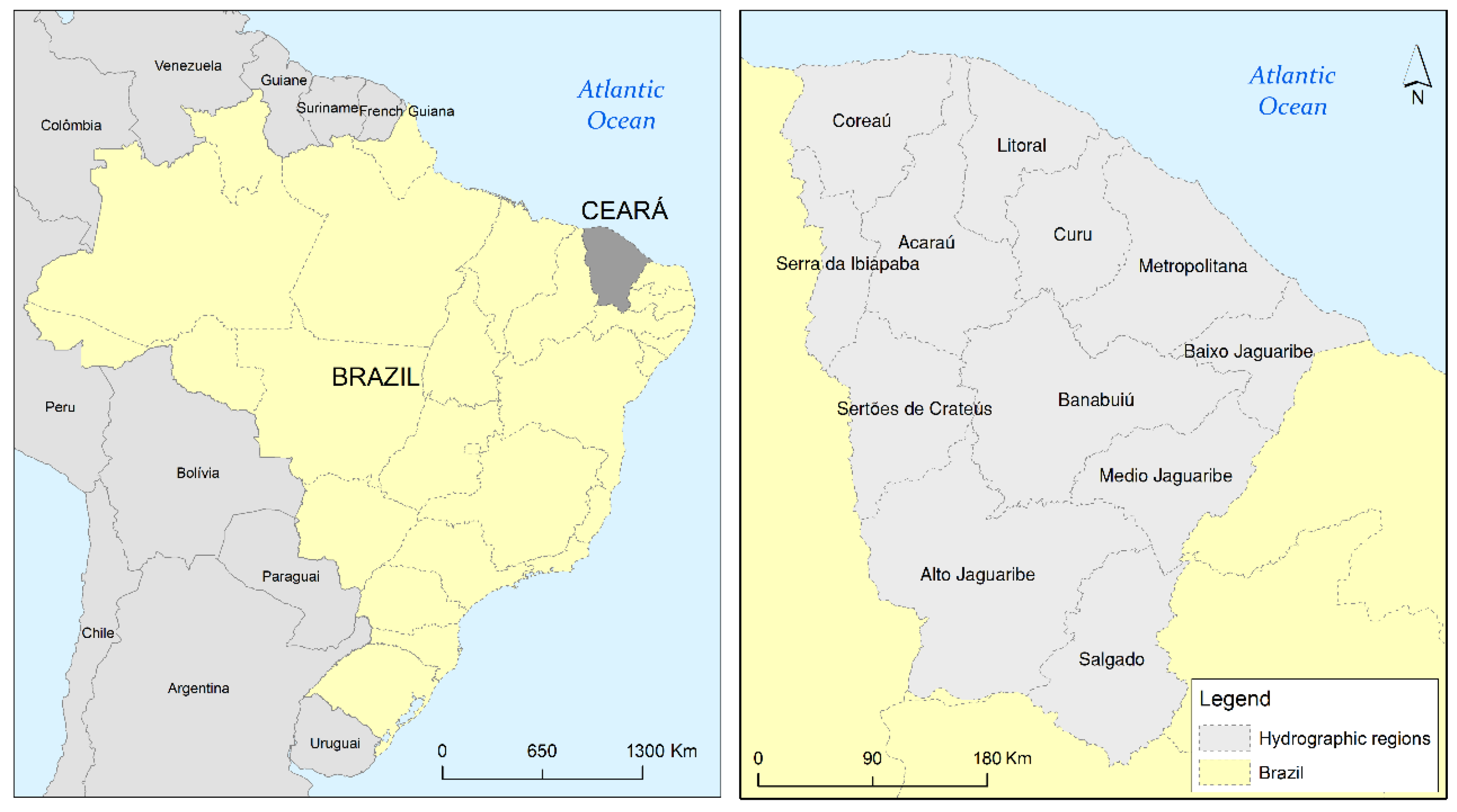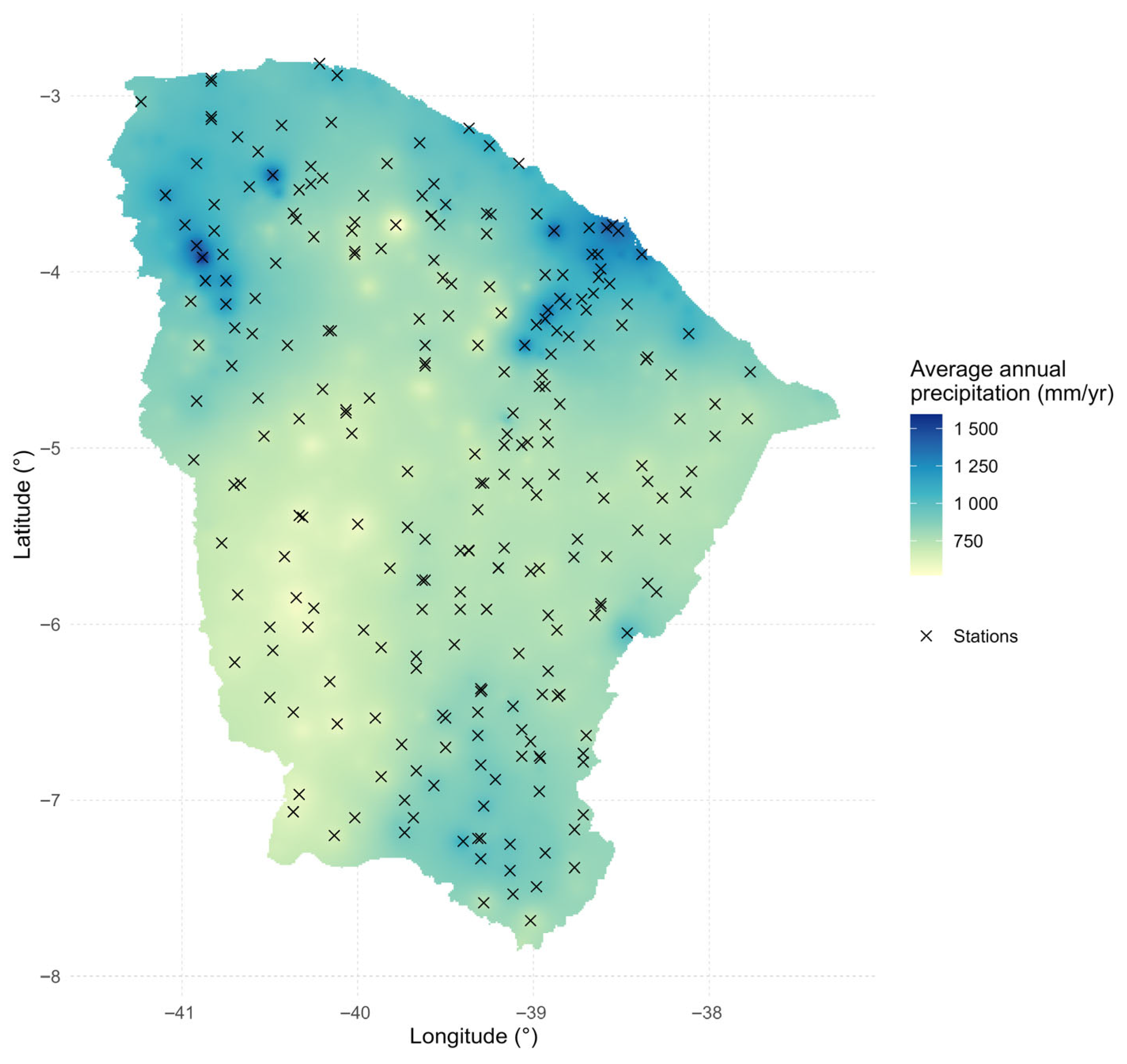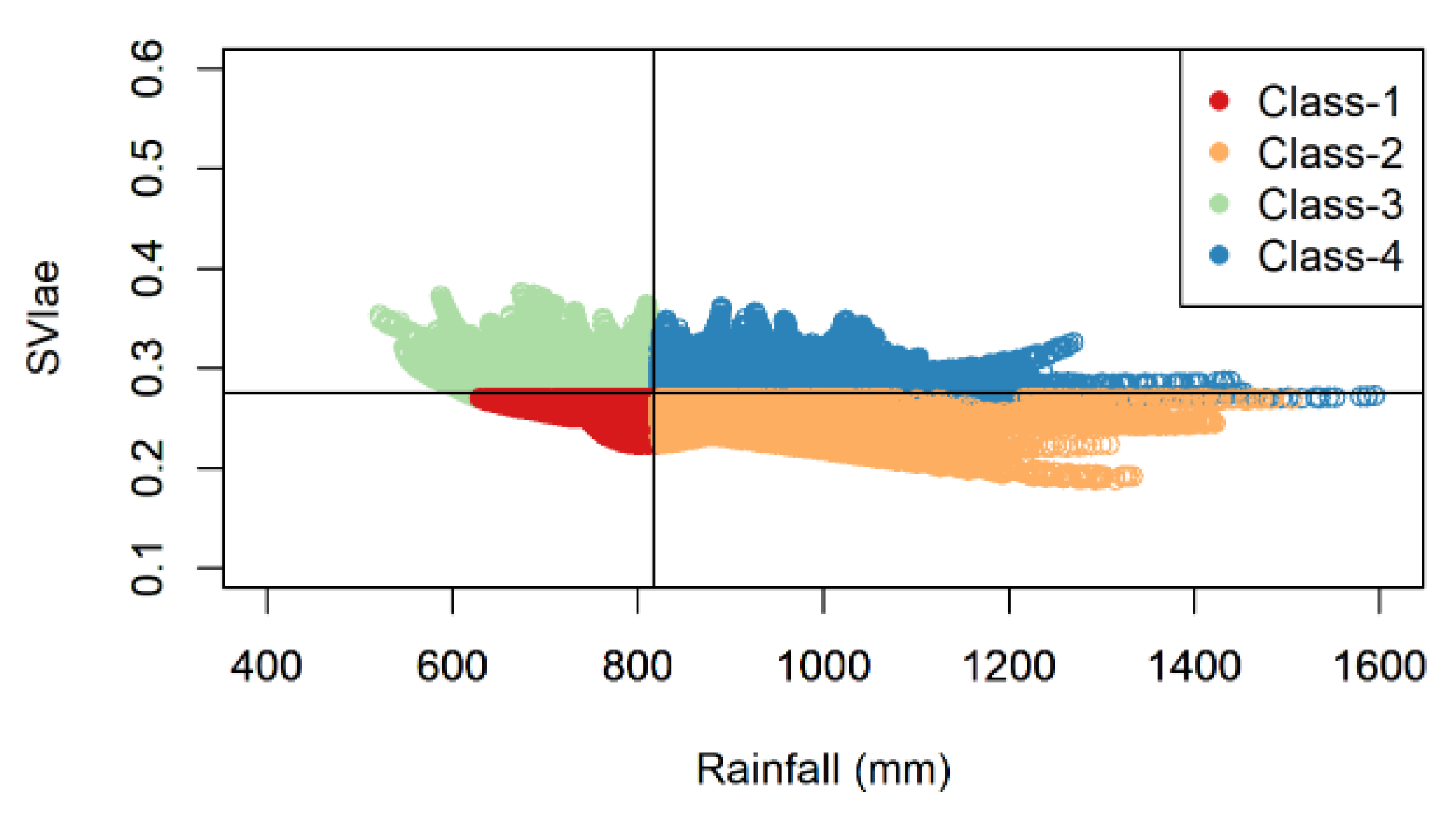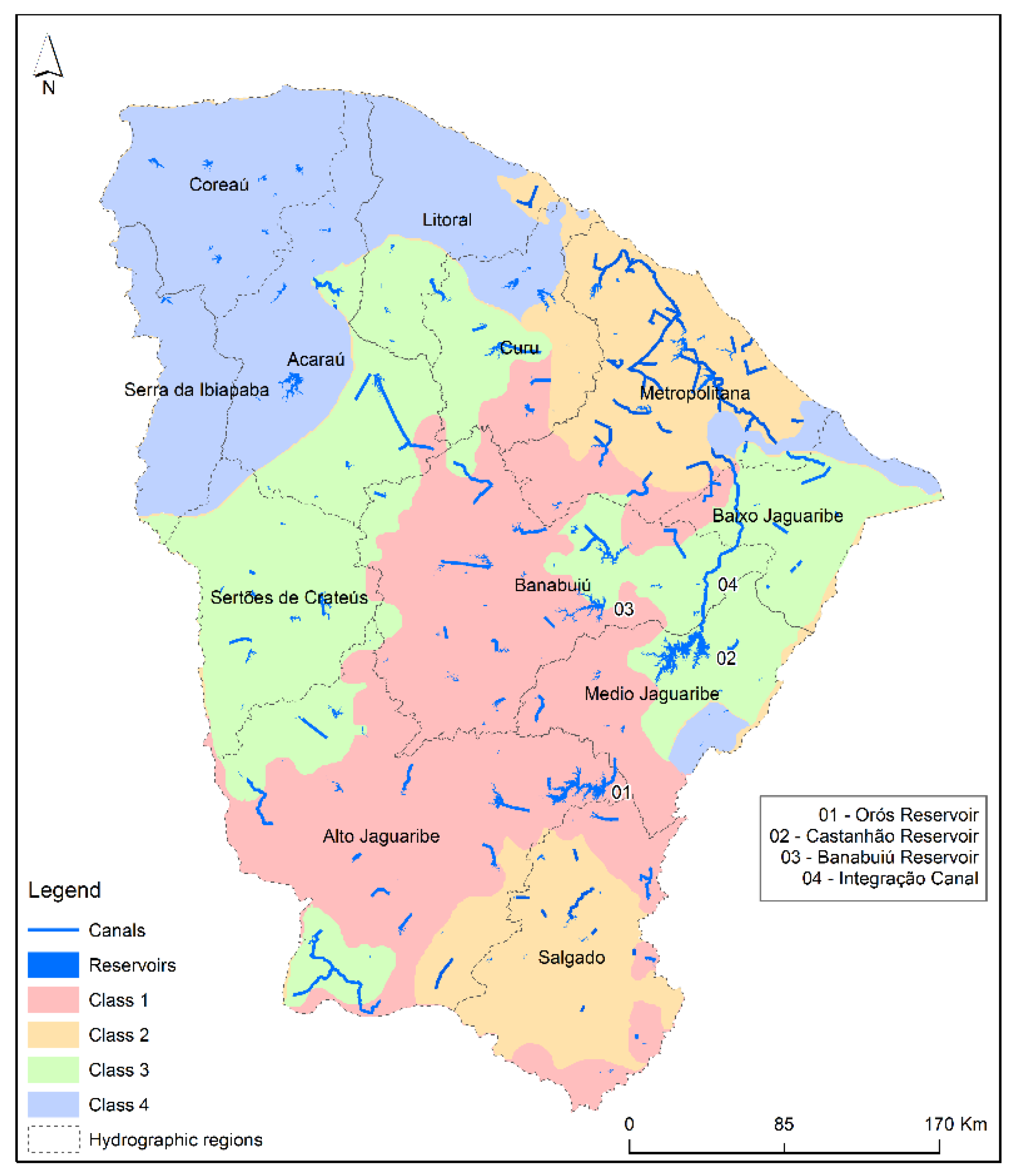Spatial Variability of Rainfall and Vulnerability Assessment of Water Resources Infrastructure for Adaptive Management Implementation in Ceará, Brazil
Abstract
1. Introduction
2. Materials and Methods
2.1. Study Area
2.2. Methods
3. Results and Discussion
Rainfall Variability and Adaptive Capacity Assessment
4. Conclusions
Author Contributions
Funding
Institutional Review Board Statement
Informed Consent Statement
Data Availability Statement
Acknowledgments
Conflicts of Interest
References
- Cirilo, J.A.; Montenegro, S.M.G.L.; Campos, J.N.B. The Issue of Water in the Brazilian Semi-Arid Region. In Waters of Brazil; Springer International Publishing: Cham, Switzerland, 2017; pp. 59–71. [Google Scholar]
- Ledru, M.-P.; Jeske-Pieruschka, V.; Bremond, L.; Develle, A.-L.; Sabatier, P.; Martins, E.S.P.R.; de Freitas Filho, M.R.; Fontenele, D.P.; Arnaud, F.; Favier, C.; et al. When Archives Are Missing, Deciphering the Effects of Public Policies and Climate Variability on the Brazilian Semi-Arid Region Using Sediment Core Studies. Sci. Total Environ. 2020, 723, 137989. [Google Scholar] [CrossRef]
- Rolim, L.; de Souza Filho, F. Shift Detection in Hydrological Regimes and Pluriannual Low-Frequency Streamflow Forecasting Using the Hidden Markov Model. Water 2020, 12, 2058. [Google Scholar] [CrossRef]
- Hasselman, L. Adaptive Management; Adaptive Co-Management; Adaptive Governance: What’s the Difference? Australas. J. Environ. Manag. 2017, 24, 31–46. [Google Scholar] [CrossRef]
- Pachauri, R.; Meyer, L. IPCC Climate Change Synthesis Report (2014) Topic 2 Future Climate Changes Risks and Impacts. Contribution of Working Groups I, II and III to the Fifth Assessment Report of the Intergovernmental Panel on Climate Change; IPCC: Geneva, Switzerland, 2014. [Google Scholar]
- de Azevedo Reis, G.; de Souza Filho, F.A.; Nelson, D.R.; Rocha, R.V.; da Silva, S.M.O. Development of a Drought Vulnerability Index Using MCDM and GIS: Study Case in São Paulo and Ceará, Brazil. Nat. Hazards 2020, 104, 1781–1799. [Google Scholar] [CrossRef]
- Simha, P.; Mutiara, Z.Z.; Gaganis, P. Vulnerability Assessment of Water Resources and Adaptive Management Approach for Lesvos Island, Greece. Sustain. Water Resour. Manag. 2017, 3, 283–295. [Google Scholar] [CrossRef]
- Kabat, P.; Schulze, R.E.; Hellmuth, M.E.; Veraart, J.A. (Eds.) Coping with Impacts of Climate Variability and Climate Change in Water Management: A Scoping Paper; DWC-Report No. DWCSSO-01; International Secretariat of the Dialogue on Water and Climate: Wageningen, The Netherlands, 2003. [Google Scholar]
- Tongal, H.; Sivakumar, B. Entropy Analysis for Spatiotemporal Variability of Seasonal, Low, and High Streamflows. Stoch. Environ. Res. Risk Assess. 2019, 33, 303–320. [Google Scholar] [CrossRef]
- Mesfin, D.; Simane, B.; Belay, A.; Recha, J.W.; Schmiedel, U. Assessing the Adaptive Capacity of Households to Climate Change in the Central Rift Valley of Ethiopia. Climate 2020, 8, 106. [Google Scholar] [CrossRef]
- Räsänen, A.; Juhola, S.; Nygren, A.; Käkönen, M.; Kallio, M.; Monge Monge, A.; Kanninen, M. Climate Change, Multiple Stressors and Human Vulnerability: A Systematic Review. Reg. Environ. Change 2016, 16, 2291–2302. [Google Scholar] [CrossRef]
- Benson, D.; Lorenzoni, I. Climate Change Adaptation, Flood Risks and Policy Coherence in Integrated Water Resources Management in England. Reg. Environ. Change 2017, 17, 1921–1932. [Google Scholar] [CrossRef]
- Decker, K.L.; Fink, M.M.; Rondeau, R.J. Triangulation in Climate Change Vulnerability Assessment: Examples from Colorado, USA. Reg. Environ. Change 2017, 17, 2467–2475. [Google Scholar] [CrossRef]
- Mateus, M.C.; Tullos, D. Reliability, Sensitivity, and Vulnerability of Reservoir Operations under Climate Change. J. Water Resour. Plan. Manag. 2017, 143, 04016085. [Google Scholar] [CrossRef]
- Vargas, J.; Paneque, P. Methodology for the Analysis of Causes of Drought Vulnerability on the River Basin Scale. Nat. Hazards 2017, 89, 609–621. [Google Scholar] [CrossRef]
- Anandhi, A.; Kannan, N. Vulnerability Assessment of Water Resources—Translating a Theoretical Concept to an Operational Framework Using Systems Thinking Approach in a Changing Climate: Case Study in Ogallala Aquifer. J. Hydrol. 2018, 557, 460–474. [Google Scholar] [CrossRef]
- Schilling, J.; Hertig, E.; Tramblay, Y.; Scheffran, J. Climate Change Vulnerability, Water Resources and Social Implications in North Africa. Reg. Environ. Change 2020, 20, 15. [Google Scholar] [CrossRef]
- Lebel, L.; Manuta, J.B.; Garden, P. Institutional Traps and Vulnerability to Changes in Climate and Flood Regimes in Thailand. Reg. Environ. Change 2011, 11, 45–58. [Google Scholar] [CrossRef]
- Tucker, J.; Daoud, M.; Oates, N.; Few, R.; Conway, D.; Mtisi, S.; Matheson, S. Social Vulnerability in Three High-Poverty Climate Change Hot Spots: What Does the Climate Change Literature Tell Us? Reg. Environ. Change 2015, 15, 783–800. [Google Scholar] [CrossRef]
- De Souza, K.; Kituyi, E.; Harvey, B.; Leone, M.; Murali, K.S.; Ford, J.D. Vulnerability to Climate Change in Three Hot Spots in Africa and Asia: Key Issues for Policy-Relevant Adaptation and Resilience-Building Research. Reg. Environ. Change 2015, 15, 747–753. [Google Scholar] [CrossRef]
- Fuentes-Castillo, T.; Hernández, H.J.; Pliscoff, P. Hotspots and Ecoregion Vulnerability Driven by Climate Change Velocity in Southern South America. Reg. Environ. Change 2020, 20, 27. [Google Scholar] [CrossRef]
- Lemos, M.C.; Puga, B.P.; Formiga-Johnsson, R.M.; Seigerman, C.K. Building on Adaptive Capacity to Extreme Events in Brazil: Water Reform, Participation, and Climate Information across Four River Basins. Reg. Environ. Change 2020, 20, 53. [Google Scholar] [CrossRef]
- Annys, S.; Demissie, B.; Abraha, A.Z.; Jacob, M.; Nyssen, J. Land Cover Changes as Impacted by Spatio-Temporal Rainfall Variability along the Ethiopian Rift Valley Escarpment. Reg. Environ. Change 2017, 17, 451–463. [Google Scholar] [CrossRef]
- Harmanny, K.S.; Malek, Ž. Adaptations in Irrigated Agriculture in the Mediterranean Region: An Overview and Spatial Analysis of Implemented Strategies. Reg. Environ. Change 2019, 19, 1401–1416. [Google Scholar] [CrossRef]
- Haghtalab, N.; Moore, N.; Ngongondo, C. Spatio-Temporal Analysis of Rainfall Variability and Seasonality in Malawi. Reg. Environ. Change 2019, 19, 2041–2054. [Google Scholar] [CrossRef]
- Mishra, A.K.; Özger, M.; Singh, V.P. An Entropy-Based Investigation into the Variability of Precipitation. J. Hydrol. 2009, 370, 139–154. [Google Scholar] [CrossRef]
- Zhang, Q.; Zheng, Y.; Singh, V.P.; Xiao, M.; Liu, L. Entropy-based Spatiotemporal Patterns of Precipitation Regimes in the Huai River Basin, China. Int. J. Climatol. 2016, 36, 2335–2344. [Google Scholar] [CrossRef]
- Su, H.-T.; You, G.J.-Y. Developing an Entropy-Based Model of Spatial Information Estimation and Its Application in the Design of Precipitation Gauge Networks. J. Hydrol. 2014, 519, 3316–3327. [Google Scholar] [CrossRef]
- Agarwal, A.; Maheswaran, R.; Sehgal, V.; Khosa, R.; Sivakumar, B.; Bernhofer, C. Hydrologic Regionalization Using Wavelet-Based Multiscale Entropy Method. J. Hydrol. 2016, 538, 22–32. [Google Scholar] [CrossRef]
- Guntu, R.K.; Rathinasamy, M.; Agarwal, A.; Sivakumar, B. Spatiotemporal Variability of Indian Rainfall Using Multiscale Entropy. J. Hydrol. 2020, 587, 124916. [Google Scholar] [CrossRef]
- da Silva, V.d.P.R.; Belo Filho, A.F.; Rodrigues Almeida, R.S.; de Holanda, R.M.; da Cunha Campos, J.H.B. Shannon Information Entropy for Assessing Space–Time Variability of Rainfall and Streamflow in Semiarid Region. Sci. Total Environ. 2016, 544, 330–338. [Google Scholar] [CrossRef]
- Bekchanov, M.; Lamers, J.P.A. Economic Costs of Reduced Irrigation Water Availability in Uzbekistan (Central Asia). Reg. Environ. Change 2016, 16, 2369–2387. [Google Scholar] [CrossRef]
- Brahmananda Rao, V.; de Lima, M.C.; Franchito, S.H. Seasonal and Interannual Variations of Rainfall over Eastern Northeast Brazil. J. Clim. 1993, 6, 1754–1763. [Google Scholar] [CrossRef]
- Hastenrath, S. Exploring the Climate Problems of Brazil’s Nordeste: A Review. Clim. Change 2012, 112, 243–251. [Google Scholar] [CrossRef]
- Marengo, J.A.; Torres, R.R.; Alves, L.M. Drought in Northeast Brazil—Past, Present, and Future. Theor. Appl. Climatol. 2017, 129, 1189–1200. [Google Scholar] [CrossRef]
- Kayano, M.T.; Andreoli, R.V.; de Souza, R.A.F. Pacific and Atlantic Multidecadal Variability Relations to the El Niño Events and Their Effects on the South American Rainfall. Int. J. Climatol. 2020, 40, 2183–2200. [Google Scholar] [CrossRef]
- Garreaud, R.D.; Vuille, M.; Compagnucci, R.; Marengo, J. Present-Day South American Climate. Palaeogeogr. Palaeoclimatol. Palaeoecol. 2009, 281, 180–195. [Google Scholar] [CrossRef]
- Andreoli, R.V.; Kayano, M.T. ENSO-Related Rainfall Anomalies in South America and Associated Circulation Features during Warm and Cold Pacific Decadal Oscillation Regimes. Int. J. Climatol. 2005, 25, 2017–2030. [Google Scholar] [CrossRef]
- Silva, S.M.O.d.; Souza Filho, F.d.A.; Aquino, S.H.S. Avaliação Do Risco Da Alocação de Água Em Período de Escassez Hídrica: O Caso Do Sistema Jaguaribe-Metropolitano. Eng. Sanit. Ambient. 2017, 22, 749–760. [Google Scholar] [CrossRef]
- Maruyama, T.; Kawachi, T.; Singh, V.P. Entropy-Based Assessment and Clustering of Potential Water Resources Availability. J. Hydrol. 2005, 309, 104–113. [Google Scholar] [CrossRef]
- Rolim, L.Z.R.; da Silva, S.M.O.; de Assis de Souza Filho, F. Analysis of precipitation dynamics at different timescales based on entropy theory: An application to the State of Ceará, Brazil. Stoch. Environ. Res. Risk Assess. 2022, 36, 2285–2301. [Google Scholar] [CrossRef]
- Kawachi, T.; Maruyama, T.; Singh, V.P. Rainfall Entropy for Delineation of Water Resources Zones in Japan. J. Hydrol. 2001, 246, 36–44. [Google Scholar] [CrossRef]
- Girão, A.R.; Dutra, I.; de Souza, F. Área irrigada e métodos Área irrigada e métodos de irrigação no Estado do Ceará, de irrigação no Estado do Ceará, segundo o Censo Agropecuário de 1995-1996. Rev. Bras. Eng. Agríc. Ambient. 2001, 5, 161–165. [Google Scholar] [CrossRef]
- Höllermann, B.; Evers, M. Integration of uncertainties in water and flood risk management. Proc. IAHS 2015, 370, 193–199. [Google Scholar] [CrossRef]
- Kundzewicz, Z.W.; Krysanova, V.; Benestad, R.E.; Hov, Ö.; Piniewski, M.; Otto, I.M. Uncertainty in climate change impacts on water resources. Environ. Sci. Policy 2018, 79, 1–8. [Google Scholar] [CrossRef]




| Reservoir | Water Storage Capacity (hm3) | Hydrographic Region |
|---|---|---|
| Banabuiú | 1601 | Banabuiú |
| Castanhão | 6700 | Médio Jaguaribe |
| Orós | 1940 | Alto Jaguaribe |
| The State of Ceará | 18,759.90 | - |
| Class | Variability (SVIAE) | Average Annual Precipitation |
|---|---|---|
| 1 | Below Average | Below Average |
| 2 | Below Average | Above Average |
| 3 | Above Average | Below Average |
| 4 | Above Average | Above Average |
| Class | Reservoirs Capacity (hm3) | Transportation Network Length (km) | Area (km2) | ACWM |
|---|---|---|---|---|
| 1 | 3872.30 | 449.95 | 45,627.4 | 0.178 |
| 2 | 1463.40 | 641.61 | 26,117.6 | 0.332 |
| 3 | 11,030.20 | 567.07 | 42,431.8 | 0.431 |
| 4 | 2394.00 | 771.02 | 34,833.8 | 0.321 |
Disclaimer/Publisher’s Note: The statements, opinions and data contained in all publications are solely those of the individual author(s) and contributor(s) and not of MDPI and/or the editor(s). MDPI and/or the editor(s) disclaim responsibility for any injury to people or property resulting from any ideas, methods, instructions or products referred to in the content. |
© 2025 by the authors. Licensee MDPI, Basel, Switzerland. This article is an open access article distributed under the terms and conditions of the Creative Commons Attribution (CC BY) license (https://creativecommons.org/licenses/by/4.0/).
Share and Cite
Reis, G.d.A.; Rolim, L.Z.R.; Studart, T.M.d.C.; Silva, S.M.O.d.; de Souza Filho, F.d.A.; Melo Rocha, M.A. Spatial Variability of Rainfall and Vulnerability Assessment of Water Resources Infrastructure for Adaptive Management Implementation in Ceará, Brazil. Sustainability 2025, 17, 9147. https://doi.org/10.3390/su17209147
Reis GdA, Rolim LZR, Studart TMdC, Silva SMOd, de Souza Filho FdA, Melo Rocha MA. Spatial Variability of Rainfall and Vulnerability Assessment of Water Resources Infrastructure for Adaptive Management Implementation in Ceará, Brazil. Sustainability. 2025; 17(20):9147. https://doi.org/10.3390/su17209147
Chicago/Turabian StyleReis, Gabriela de Azevedo, Larissa Zaira Rafael Rolim, Ticiana Marinho de Carvalho Studart, Samiria Maria Oliveira da Silva, Francisco de Assis de Souza Filho, and Maria Aparecida Melo Rocha. 2025. "Spatial Variability of Rainfall and Vulnerability Assessment of Water Resources Infrastructure for Adaptive Management Implementation in Ceará, Brazil" Sustainability 17, no. 20: 9147. https://doi.org/10.3390/su17209147
APA StyleReis, G. d. A., Rolim, L. Z. R., Studart, T. M. d. C., Silva, S. M. O. d., de Souza Filho, F. d. A., & Melo Rocha, M. A. (2025). Spatial Variability of Rainfall and Vulnerability Assessment of Water Resources Infrastructure for Adaptive Management Implementation in Ceará, Brazil. Sustainability, 17(20), 9147. https://doi.org/10.3390/su17209147








